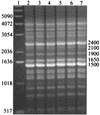DNA fingerprinting of Lactobacillus crispatus strain CTV-05 by repetitive element sequence-based PCR analysis in a pilot study of vaginal colonization
- PMID: 12734221
- PMCID: PMC154705
- DOI: 10.1128/JCM.41.5.1881-1887.2003
DNA fingerprinting of Lactobacillus crispatus strain CTV-05 by repetitive element sequence-based PCR analysis in a pilot study of vaginal colonization
Abstract
Lactobacillus crispatus is one of the predominant hydrogen peroxide (H(2)O(2))-producing species found in the vagina and is under development as a probiotic for the treatment of bacterial vaginosis. In this study, we assessed whether DNA fingerprinting by repetitive element sequence-based PCR (rep-PCR) can be used to distinguish the capsule strain of L. crispatus (CTV-05) from other endogenous strains as well as other species of vaginal lactobacilli. Vaginal and rectal lactobacilli were identified to the species level by using whole-chromosome probe DNA hybridization. The DNAs from L. crispatus, L. jensenii, L. gasseri, and an as-yet-unnamed H(2)O(2)-negative Lactobacillus species designated 1086V were subjected to rep-PCR. The results of gel electrophoresis and ethidium bromide staining of the DNA fingerprints obtained were compared. L. crispatus CTV-05 had a unique DNA fingerprint compared to all other lactobacilli. DNA fingerprints for 27 production lots of L. crispatus sampled from 1994 through 2001 were identical to that of the original strain isolated in 1993, suggesting strain stability. In a pilot study of nine women, this DNA fingerprinting method distinguished CTV-05 from other endogenous vaginal lactobacilli prior to and after vaginal capsule use. rep-PCR DNA fingerprinting is useful for strain typing and for evaluating longitudinal loss or acquisition of vaginal lactobacilli used as probiotics.
Figures



Similar articles
-
Vaginal colonization by probiotic Lactobacillus crispatus CTV-05 is decreased by sexual activity and endogenous Lactobacilli.J Infect Dis. 2009 May 15;199(10):1506-13. doi: 10.1086/598686. J Infect Dis. 2009. PMID: 19331578 Clinical Trial.
-
[Selection and genotyping of lactobacillus with potential preventive effect by repetitive element sequence-based PCR analysis].Sheng Wu Gong Cheng Xue Bao. 2011 May;27(5):817-23. Sheng Wu Gong Cheng Xue Bao. 2011. PMID: 21845850 Chinese.
-
The identification of vaginal Lactobacillus species and the demographic and microbiologic characteristics of women colonized by these species.J Infect Dis. 1999 Dec;180(6):1950-6. doi: 10.1086/315109. J Infect Dis. 1999. PMID: 10558952
-
Vaginal microbiota and the potential of Lactobacillus derivatives in maintaining vaginal health.Microb Cell Fact. 2020 Nov 7;19(1):203. doi: 10.1186/s12934-020-01464-4. Microb Cell Fact. 2020. PMID: 33160356 Free PMC article. Review.
-
Lactobacilli and Their Probiotic Effects in the Vagina of Reproductive Age Women.Microorganisms. 2023 Mar 1;11(3):636. doi: 10.3390/microorganisms11030636. Microorganisms. 2023. PMID: 36985210 Free PMC article. Review.
Cited by
-
Randomized Trial of Lactin-V to Prevent Recurrence of Bacterial Vaginosis.N Engl J Med. 2020 May 14;382(20):1906-1915. doi: 10.1056/NEJMoa1915254. N Engl J Med. 2020. PMID: 32402161 Free PMC article. Clinical Trial.
-
Recovery of Indigenous probiotic Lactobacillus plantarum Mut-7 on healthy Indonesian adults after consumption of fermented milk containing these bacteria.J Food Sci Technol. 2021 Sep;58(9):3525-3532. doi: 10.1007/s13197-021-05046-z. Epub 2021 Apr 29. J Food Sci Technol. 2021. PMID: 34366469 Free PMC article.
-
Lactobacillus proteins are associated with the bactericidal activity against E. coli of female genital tract secretions.PLoS One. 2012;7(11):e49506. doi: 10.1371/journal.pone.0049506. Epub 2012 Nov 19. PLoS One. 2012. PMID: 23185346 Free PMC article.
-
A Chinese rhesus macaque (Macaca mulatta) model for vaginal Lactobacillus colonization and live microbicide development.J Med Primatol. 2009 Apr;38(2):125-36. doi: 10.1111/j.1600-0684.2008.00316.x. J Med Primatol. 2009. PMID: 19367737 Free PMC article.
-
Protective Properties of S-layer Protein 2 from Lactobacillus crispatus 2029 against Candida albicans Infections.Biomolecules. 2023 Dec 4;13(12):1740. doi: 10.3390/biom13121740. Biomolecules. 2023. PMID: 38136611 Free PMC article.
References
-
- Antonio, M. A. D., S. E. Hawes, and S. L. Hillier. 1999. The identification of vaginal Lactobacillus species and the demographic and microbiologic characteristics of women colonized by these species. J. Infect. Dis. 180:1950-1956. - PubMed
-
- Cohen, C. R., A. Duerr, N. Pruithithada, S. Rugpao, S. Hillier, P. Garcia, and K. Nelson. 1995. Bacterial vaginosis and HIV-seroprevalence among female commercial sex workers in Chiang Mai, Thailand. AIDS 9:1093-1097. - PubMed
-
- Collins, J. K., G. Thornton, and G. O. Sullivan. 1998. Selection of probiotic strains for human applications. Int. Dairy J. 8:487-490.
-
- Collins, M. D., B. A. Phillips, and P. Zanoni. 1989. Deoxyribonucleic acid homology studies of Lactobacillus casei, Lactobacillus paracasei sp. nov., subsp. paracasei and subsp. tolerans, and Lactobacillus rhamnosus sp. nov., comb. nov. Int. J. Syst. Bacteriol. 39:105-108.
-
- Cu-Uvin, S., J. W. Hogan, A. M. Caliendo, J. Harwell, K. H. Mayer, and C. C. J. Carpenter. 2001. Association between bacterial vaginosis and expression of human immunodeficiency virus type 1 RNA in the female genital tract. Clin. Infect. Dis. 33:894-896. - PubMed
Publication types
MeSH terms
Substances
Grants and funding
LinkOut - more resources
Full Text Sources
Other Literature Sources
Medical
Molecular Biology Databases

